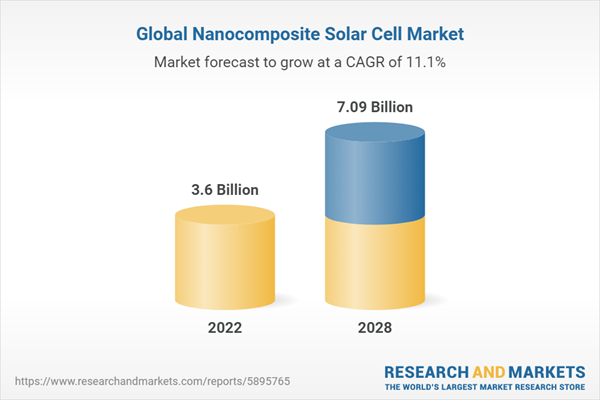Dublin, March 20, 2024 (GLOBE NEWSWIRE) -- The "Global Nanocomposite Solar Cell Market - Industry Size, Share, Trends, Opportunity, and Forecast, 2018-2028" report has been added to ResearchAndMarkets.com's offering.
The Global Nanocomposite Solar Cell Market was valued at USD 3.6 billion in 2022 and is anticipated to project robust growth in the forecast period with a CAGR of 11.05% through 2028.
Nanocomposite solar cells are a type of photovoltaic device that incorporates nanoscale materials, typically nanoparticles, into the structure of the solar cell to enhance its performance and efficiency. These nanomaterials are often engineered to have specific properties that can improve the absorption of sunlight, the generation and separation of charge carriers, and overall energy conversion efficiency.
The term "nanocomposite" refers to the incorporation of nanoscale materials into the solar cell's active layer. These nanomaterials can include nanoparticles of various materials such as quantum dots, nanowires, nanorods, or nanotubes. These materials may be chosen for their unique electrical, optical, or structural properties. Nanocomposite materials are designed to enhance light absorption by extending the range of wavelengths that can be captured by the solar cell. This can lead to increased efficiency in converting sunlight into electricity.
Nanoparticles in nanocomposite solar cells can facilitate the separation of photoexcited electrons and holes more efficiently. This separation is crucial for generating an electric current. by carefully engineering the nanomaterials, researchers aim to minimize the recombination of charge carriers (electrons and holes) within the solar cell, which can reduce overall efficiency.
Nanocomposite solar cells can often be fabricated on flexible substrates, making them suitable for various applications, including portable devices and building-integrated solar panels. This flexibility can also make them lightweight. Nanocomposite solar cells offer opportunities for tuning the properties of the nanomaterials to optimize performance for specific applications or environmental conditions.
It's important to note that while nanocomposite solar cells hold promise for improved solar energy conversion, they are still undergoing research and development, and commercialization may vary depending on advancements in the technology. Additionally, the specific properties and materials used in nanocomposite solar cells can vary widely among research groups and companies, making it essential to consult the latest literature and industry reports for the most up-to-date information on this technology. 
Key Market Players
- First Solar
- SunPower Corporation
- Hanwha Q Cells
- JA Solar
- Canadian Solar
- Trina Solar
- JinkoSolar
- Longi Solar
- Yingli Solar
- Risen Energy
Report Scope
In this report, the Global Nanocomposite Solar Cell Market has been segmented into the following categories, in addition to the industry trends which have also been detailed below:
Global Nanocomposite Solar Cell Market, by Type:
- Organic
- Inorganic
Global Nanocomposite Solar Cell Market, by Material Type:
- a-Si
- CdTe
- CI(G)S
- Others
Global Nanocomposite Solar Cell Market, by Application BIPV:
- Building Integrated PV
- Vehicle Integrated PV
- Fabric Integrated PV
Global Nanocomposite Solar Cell Market, by Region:
- North America
- Asia-Pacific
- Europe
- South America
- Middle East & Africa
For more information about this report visit https://www.researchandmarkets.com/r/unhqz7
About ResearchAndMarkets.com
ResearchAndMarkets.com is the world's leading source for international market research reports and market data. We provide you with the latest data on international and regional markets, key industries, the top companies, new products and the latest trends.
Attachment
